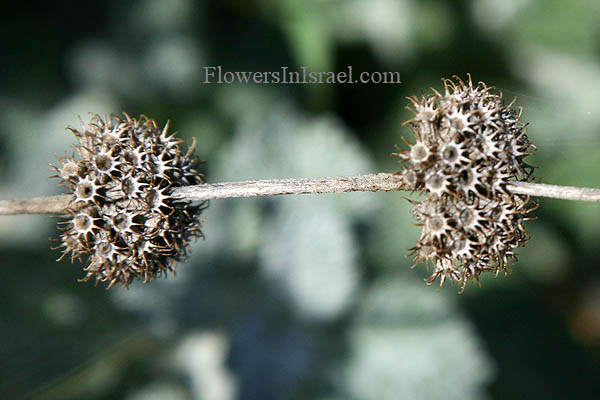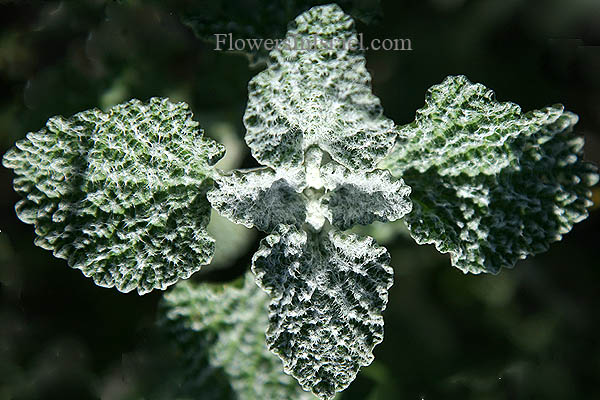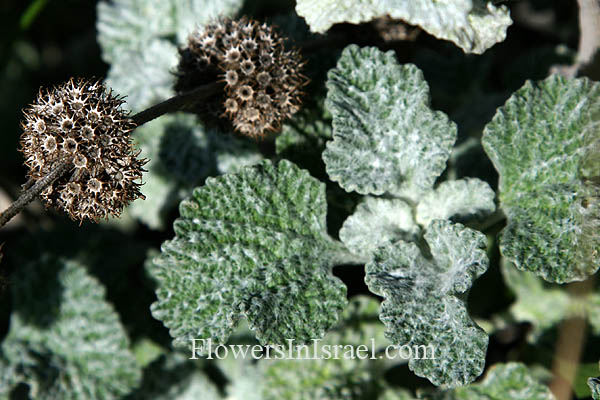Hebrew: מרמר מצוי, Arabic: سموه
| Scientific name: | Marrubium vulgare L. | |
| Common name: | White Horehound | |
| Hebrew name: | מרמר מצוי,מרוביון מצוי | |
| Arabic name: | سموه | |
| Family: | Labiatae / Lamiaceae, Mint Family, שפתניים |

Location: Hashfela |
| Life form: | Chamaephyte, semi-shrub | |
| Stems: | Up to 50 cm tall; ascending to erect | |
| Leaves: | Opposite, entire, round-ovate, covered with different glandular trichomes | |
| Inflorescence: | Verticillasters globose, many-flowered, distant | |
| Flowers: | White flowers, borne in clusters on the upper part of the main stem | |
| Fruits / pods: | Nutlets, a burr (a prickly seed case or flower head that clings to clothing and animal fur) with backward facing hooks; Seeds, c. 2mm long, with a roughened surface | |
| Flowering Period: | April, May, June | |
| Habitat: | Nutrient-rich soils, ruderal | |
| Distribution: | Mediterranean Woodlands and Shrublands, Semi-steppe shrublands, Shrub-steppes, Deserts and extreme deserts, Montane vegetation of Mt. Hermon | |
| Chorotype: | Med - Irano-Turanian | |
| Summer shedding: | Perennating |

Location: Hashfela Derivation of the botanical name: Marrubium is said to be derived from Maria urbs, an ancient town of Italy. Other authors derive its name from the Hebrew marrob (a bitter juice), and state that it was one of the bitter herbs which the Jews were ordered to take for the Feast of Passover. vulgare, "common". The common name horehound comes from the Old English words har and hune, meaning downy plant. This descriptive name refers to the white hairs that give this herb its distinctive hoary appearance. Another suggested derivation is from Horus, the Egyptian god of sky and light. The Hebrew name: מרמר ,מרוביון, marrubion, a transliteration from the scientific name; מרמר, marmar from mar:to be bitter.
It was a principal ingredient in the Caesar's antidote for vegetable poisons. Marrubium is an aromatic plant and extremely bitter. The herb has long been noted for its efficacy in lung troubles and coughs. It was already known to have healing properties in Egypt and Greece some 200o years ago. See the list of Medicinal herbs in Israel, the parts used and their medical uses to treat various diseases. Gaius Plinius Secundus, Pliny the Elder (23-79 CE), Roman historian and author of "Natural History", Book XX,LXXXIX: "Most authorities have placed among the especially valuable plants horehound, called by some Greeks prasion, by others linostrophon..." John Gerard (1545 – 1611/12), an English botanist:"Syrup made of the greene fresh leaves and sugar is a most singular remedie against the cough and wheezing of the lungs . . . and doth wonderfully and above credit ease such as have been long sicke of any consumption of the lungs, as hath beene often proved by the learned physitions of our London College." Nicholas Culpeper (October 1616 – 1654) wrote: "It helpeth to expectorate tough phlegm from the chest, being taken with the roots of Irris or Orris.... There is a syrup made of this plant which I would recommend as an excellent help to evacuate tough phlegm and cold rheum from the lungs of aged persons, especially those who are asthmatic and short winded." 
Location: Hashfela |